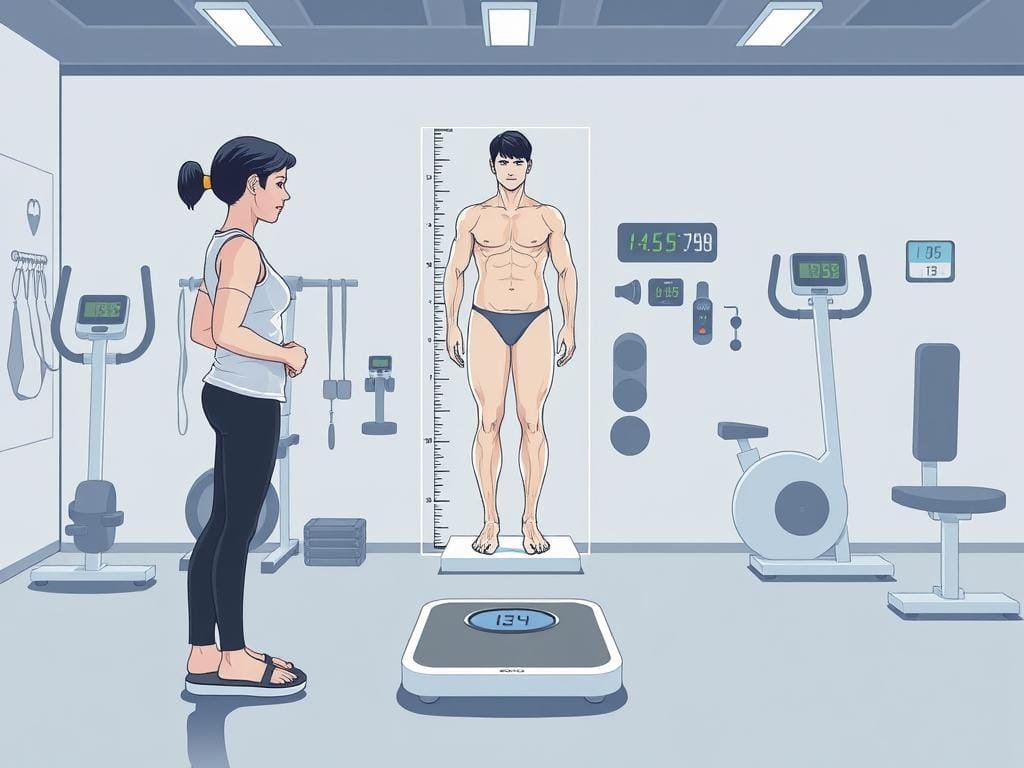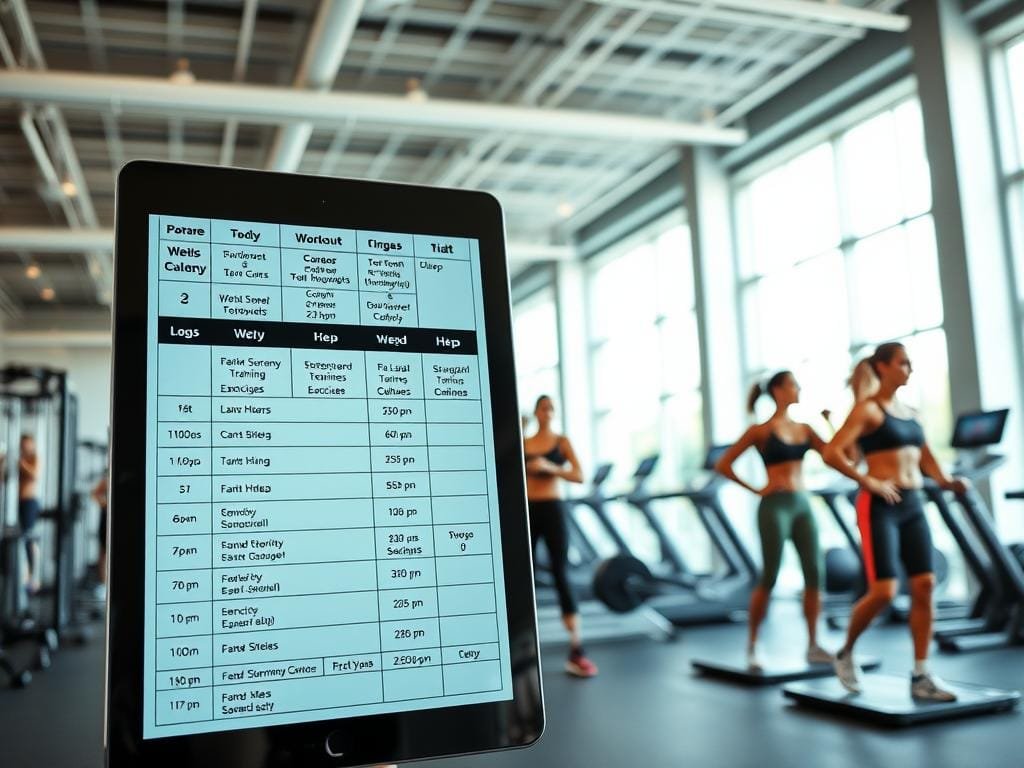Trying to lose fat? Aim for at least 300 minutes of moderately intense activity each week. This can really help you reach your fat loss goals. Exercise is key for burning calories and building muscle. This boosts your metabolism.
You don’t need to be a fitness pro to see the value of exercise routines in losing weight. Mixing cardio, strength training, and flexibility exercises creates a balanced plan. It supports your health and fat loss goals.
Starting this journey means being consistent and patient. With the right strategy, you can hit your goals and live a healthy, active life.
Table of Contents
The Science of Fat Loss
Knowing how fat loss works is key to losing weight. To lose weight, you must understand how your body uses fat for energy. Different factors play a role in this process.
How Your Body Burns Fat
Your body turns fat into energy. This process is influenced by your metabolism, diet, and how active you are. If you eat fewer calories than you burn, your body uses fat for energy, helping you lose weight.
Caloric Deficit: The Essential Component
A caloric deficit is vital for losing fat. This means eating fewer calories than your body needs. For example, if you need 2,500 calories a day, eating 2,000 calories creates a deficit. This makes your body use stored fat for energy.
Exercise’s Role in Fat Metabolism
Exercise is important for fat metabolism. It increases your energy use and builds muscle. This boosts your resting metabolic rate. Different exercises, like cardio and strength training, help with fat loss.
| Exercise Type | Impact on Fat Loss | Metabolic Effect |
|---|---|---|
| Cardiovascular Exercise | Directly burns calories | Improves cardiovascular health |
| Strength Training | Builds muscle mass | Boosts resting metabolic rate |
| High-Intensity Interval Training (HIIT) | High caloric burn | Enhances metabolic rate post-exercise |
By knowing how your body burns fat and using the right metabolism boosters, like exercise and a balanced diet, you can reach your weight loss goals more easily.
Assessing Your Current Fitness Level
Knowing your current fitness level is key to a good exercise plan. It helps you see what you’re good at and what you need to work on. This way, you can make your workout fit your needs better.
Simple Tests to Determine Your Starting Point
To find where you start, try simple tests. These tests check your heart health and muscle strength. They give you a starting point to measure how far you’ve come.
Cardiovascular Endurance Assessment
A good test for heart health is the 12-minute walk/run test. See how far you can go in 12 minutes. You can walk, jog, or run. It shows how well your heart and lungs work.
Strength Baseline Measurements
To check your muscle strength, do bodyweight exercises like push-ups, squats, or lunges. Count how many you can do until you get tired. This shows your muscle strength level.

Setting Realistic Fat Loss Goals
After knowing your fitness level, set fat loss goals. Aim to lose 1-2 pounds a week. This is a safe and sustainable target.
“The key to successful weight loss is setting achievable goals and maintaining a consistent routine.”
Having clear, measurable goals keeps you motivated and lets you see your progress.
Understanding your fitness level and setting realistic goals helps you make a good exercise plan. This plan should include healthy eating and diet tips to help you lose fat.
Cardiovascular Exercises for Fat Loss
To lose fat effectively, adding cardio to your routine is key. Cardio exercises boost your heart rate and improve heart, lung, and circulation health.
High-Intensity Interval Training (HIIT)
HIIT mixes short, intense exercise with brief rest or low-intensity periods. It’s a top choice for burning fat.
Sample HIIT Workout Routines
A basic HIIT workout might be 30 seconds of sprinting followed by 30 seconds of walking. Repeat this for 15-20 minutes. It’s a quick way to burn fat.
- Sprinting intervals
- Burpees
- Jumping jacks
- Mountain climbers
Proper Form and Technique
For effective HIIT and safety, focus on proper form and technique. Always warm up and cool down to avoid muscle injuries.
Steady-State Cardio Options
Steady-state cardio means keeping a steady, moderate exercise pace for longer. Activities like jogging, cycling, and swimming are good examples. For more on cardio for weight loss, check Healthline’s guide.
| Activity | Duration | Intensity |
|---|---|---|
| Jogging | 30-60 minutes | Moderate |
| Cycling | 30-60 minutes | Moderate |
| Swimming | 20-40 minutes | Moderate to High |
Combining Different Cardio Methods
Mixing HIIT with steady-state cardio keeps workouts fresh and prevents plateaus. Try HIIT on Monday and steady-state cardio on Wednesday.
Adding various cardio exercises to your routine boosts fat loss. Remember, losing fat takes time and consistency.
Strength Training for Effective Fat Loss
Strength training is key for losing fat. It builds muscle and boosts your metabolism. When you do strength training, you burn calories during the workout. You also increase your resting metabolic rate because of the muscle gain.
Building Muscle to Increase Metabolic Rate
Building muscle through strength training raises your metabolic rate. This means you burn more calories even when you’re not working out. Muscle tissue needs more energy than fat tissue, which is why it’s important for losing fat.
Compound Exercises That Maximize Results
Compound exercises work on multiple muscle groups at once. They are efficient and effective for building muscle and boosting metabolism.
Squats, Deadlifts, and Presses
Squats, deadlifts, and presses are compound exercises. They work on multiple joints and muscle groups. For example, squats work your legs, glutes, and core. Deadlifts engage your back, legs, and glutes.
Full-Body Movements
Adding full-body movements to your strength training routine can maximize your results. These exercises build muscle, improve coordination, and boost overall fitness.
| Exercise | Muscle Groups | Benefits |
|---|---|---|
| Squats | Legs, Glutes, Core | Builds lower body strength, improves balance |
| Deadlifts | Back, Legs, Glutes | Strengthens back and lower body, enhances overall power |
| Presses | Shoulders, Chest, Triceps | Improves upper body strength, enhances muscle mass |
Recommended Rep Ranges and Weight Selection
Choosing the right weight and rep range is important for strength training. Pick a weight that lets you do the desired number of reps with good form but challenges you.

For muscle building and metabolism boost, aim for 8-12 reps. This range stimulates muscles well without sacrificing form.
The Most Effective Fat Loss Exercise Combinations
Combining different exercises can really help you lose weight. Adding various exercises to your routine makes your workouts more intense and efficient. This leads to better results in your weight loss journey.
Full-Body Circuit Training
Full-body circuit training is a series of exercises that target different muscles. You do them one after another with little rest. It’s great for burning fat because it keeps your heart rate up and works many muscles at once.
Sample Circuit Workouts
A circuit workout might include:
- Burpees
- Mountain climbers
- Dumbbell squats
- Push-ups
- Plank jacks
Do each exercise for 30 seconds to 1 minute. Then, rest for 15-30 seconds before starting the next one. Repeat the circuit 2-3 times.
Superset Workouts for Time Efficiency
Superset workouts are two exercises done one after another without resting. This method makes your workout more intense and saves time. For example, doing a chest press followed by a row works opposing muscles well.
For more tips on effective weight loss strategies, visit effective weight loss tips for lasting.
Metabolic Resistance Training
Metabolic Resistance Training (MRT) uses resistance exercises to boost your metabolism and aid in fat loss. It involves using moderate to high weights with higher repetitions and little rest between sets.
Implementation Strategies
To do MRT well, choose compound exercises like squats, deadlifts, and bench presses. Do 3-4 sets of 8-12 reps for each exercise. Rest for 60-90 seconds between sets. This not only builds muscle but also increases your metabolic rate, helping you burn more calories even when you’re not working out.

Adding these effective fat loss exercise combinations to your routine can help you reach your weight loss goals faster. Make sure to balance your exercise with proper nutrition and enough rest to get the best results.
Creating Your Fat Loss Workout Schedule
Creating a workout schedule is key to losing fat. You need to balance hard workouts with rest. This helps your body recover and lose weight.
Optimal Weekly Training Frequency
Finding the right number of workouts a week is important. Studies show that 3-4 days of hard exercise can help you lose weight. But, it depends on your fitness level and goals.
| Training Frequency | Workout Type | Expected Fat Loss |
|---|---|---|
| 3 times/week | Moderate Intensity | Moderate |
| 4-5 times/week | High Intensity | High |
Balancing Intensity and Recovery
It’s important to balance intensity and recovery. Too much exercise can lead to fatigue and injury. For tips on losing fat, check out a guide on fat loss.
“Recovery is just as important as the workout itself. It’s during recovery that your body repairs and grows stronger.”
Progressive Overload for Continued Results
To keep losing weight, add progressive overload to your workouts. This means slowly increasing the weight or intensity.
When and How to Increase Difficulty
Up your workout game when it gets too easy. Try adding weight, increasing reps, or decreasing rest time. For example, go from 3 sets of 10 reps to 3 sets of 12 reps.

Nutrition Strategies to Support Your Fat Loss Exercise
To reach your fat loss goals, you need to exercise well and eat right. Good nutrition helps your workouts, boosts performance, and helps you recover.
Pre-Workout Nutrition for Optimal Performance
It’s key to fuel up before working out. Eat a meal with complex carbohydrates and lean protein 1-2 hours before. A good meal is brown rice, chicken, and steamed veggies. Don’t forget healthy fats like nuts or avocado for extra nutrition.
Post-Workout Nutrition for Recovery
Refueling after your workout is important for recovery and muscle repair. Eat carbs and protein within 30-60 minutes to refill energy and help muscles grow. Try a shake with whey protein and banana or grilled salmon with quinoa and veggies. For more tips on digestion and fat loss, check out this resource.
Hydration and Its Impact on Fat Loss
Drinking enough water is key for health and fat loss. It helps with body temperature, nutrient transport, and waste removal. Not drinking enough can hurt your performance and recovery.
Daily Water Requirements
Drink 8-10 glasses of water a day, depending on your activity and where you live. Eating hydrating foods like cucumbers, watermelon, and celery also helps. Here are some hydration tips:
- Drink a glass of water as soon as you wake up.
- Carry a water bottle with you all day.
- Check your urine color; it should be pale yellow.
Common Fat Loss Exercise Mistakes to Avoid
To lose weight effectively, knowing common mistakes is key. Many people face challenges in their fat loss journey. This is often due to simple mistakes in their exercise routines.
Overtraining and Its Consequences
Overtraining can cause burnout, injury, and slow down your weight loss. It’s important to find a balance. This means exercising regularly but also giving your body time to recover.
Neglecting Recovery and Sleep
Recovery and sleep are as vital as exercise for weight loss. Sleep helps your body repair and build muscle. Not getting enough sleep can mess with your hunger and fullness hormones, leading to weight gain.
Program Hopping: The Progress Killer
Switching workout programs too often can stop your progress. Sticking to one routine is important for seeing results in your fat loss journey.
Consistency vs. Variety
Adding variety to your workouts can prevent plateaus. But too much change can be bad. Finding the right mix of consistency and variety is key for lasting success in weight loss.
Tracking Progress Beyond the Scale
Starting your fat loss journey means more than just watching the scale. It’s important to look at other ways to measure success. This includes different assessments to show how you’re doing.
Body Measurements and Composition
Measuring your body can give you insights into your fat loss. Use a tape measure for your waist, hips, and other key areas. Body fat calipers can also show your body fat percentage. These tools help you see changes, even if the scale doesn’t show it right away. For more weight loss tips, check out resources with diet and healthy eating advice.
Performance Metrics to Monitor
It’s also important to track how you do in workouts and daily activities. Keep an eye on:
- Exercise duration and intensity
- Number of repetitions or sets completed
- Resting heart rate and recovery time
These signs show you’re getting better at heart health and fitness.
Visual Assessment and Progress Photos
Progress photos can be a big motivator. Seeing changes in your body can be more inspiring than just weight loss. Take photos from different angles to show your progress fully.
Creating a Tracking System
To track your progress well, make a system that suits you. This could be:
- A spreadsheet for your measurements and performance
- A journal for your workouts, diet, and feelings
- A mobile app for fitness and nutrition tracking
Pick something you like and can keep up with. It should fit your life and help you stay on track.
Adapting Your Fat Loss Exercise Routine Over Time
As you move forward in your fat loss journey, it’s key to change your exercise routine. Your body gets used to things quickly, so what works today might not tomorrow. Changing your routine is vital to keep challenging your muscles and heart, helping you lose fat and get fitter.
When and How to Increase Intensity
Boosting the intensity of your workouts is key for ongoing success. You can do this by adding weights, reps, or sets, or by shortening rest times. Slowly increasing intensity helps avoid hitting a wall and keeps workouts fun. For example, try High-Intensity Interval Training (HIIT), which is great for losing fat.
Breaking Through Plateaus
Plateaus are a common part of losing fat. To get past them, find out why and tweak your routine. Switching up your exercises or workout styles can kickstart progress again.
Plateau-Busting Techniques
Effective ways to beat plateaus include changing where you work out, trying new exercises, or tweaking your diet. Mixing things up keeps your body on its toes and helps you get past a plateau.
Periodization for Long-Term Success
Periodization means changing your workout routine to avoid burnout and plateaus. By switching between intense and easy periods, you can maximize fat loss and keep making progress. This method allows for rest and keeps you improving, making it a cornerstone of successful fat loss.
Special Considerations for Different Fitness Levels
Different fitness levels need special approaches to losing fat. It’s important to know this for success. Tailoring your workout to your fitness level helps you reach your goals better.
Modifications for Beginners
For beginners, starting with low-impact exercises is key. These exercises reduce the risk of injury. They help your body get used to the new demands.
Low-Impact Alternatives
Beginners can try low-impact alternatives like swimming, cycling, or elliptical machines. These activities are great for a heart workout without hurting your joints.
Intermediate Progression Strategies
When you get to an intermediate level, you can add more intense exercises. This might include interval training or strength training with moderate weights.
Intermediate exercisers should aim for progressive overload. This means making your workouts more intense over time to keep improving.
Advanced Techniques for Experienced Exercisers
Advanced exercisers can do high-intensity workouts. This includes HIIT (High-Intensity Interval Training) and advanced strength training techniques.
Advanced Fat Loss Protocols
Experienced individuals can try advanced fat loss protocols. These involve complex workout plans and periodized training. This keeps your body challenged and prevents plateaus.
Understanding your fitness level and adjusting your workouts is key for fat loss. Adding healthy eating habits helps you lose weight and stay healthy.
Conclusion: Sustaining Your Fat Loss Journey
To keep losing fat, you need to keep exercising and eating healthy. You’ve learned how fat loss works, why cardio is key, and how strength training helps.
Keep your weight loss going by mixing up your workouts and eating right. A good workout plan and healthy eating are essential. Don’t forget to avoid mistakes like overtraining and not resting enough.
Tracking your progress and changing your routine as needed is important for lasting success. Healthy habits and regular exercise will become a big part of your life. This will help you keep your weight off and stay healthy.

